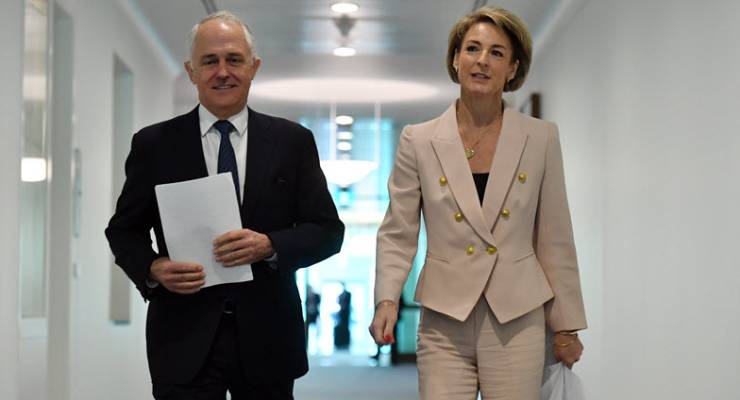
A prominent ABC News report late last week contained several messages which the Turnbull Government wants voters to believe are true. They aren’t. Apparently hoping to boost the Coalition’s tawdry record on jobs, it opened with:
“Australia’s unemployment rate has fallen to 5.6% with the creation of nearly 28,000 jobs in July.”
Excellent! Except, no, it hasn’t.
The first sneaky trick is switching between the trend and seasonally adjusted figures the Australian Bureau of Statistics (ABS) provides. Most commentators generally (and this Crikey reporter always) use seasonally adjusted data. The ABC’s Michael Janda here uses either, as suits the argument.
The first sentence, above, relates to seasonally adjusted numbers. The trend number of total jobs is lower. But when he reports on full-time jobs created, he switches to the trend data. This shows 28,600 full-time jobs added in July. Seasonally adjusted, 20,300 full-time jobs were lost.
There are at least three other problematic paragraphs.
The shift to part-time and casual
The article asserts: “The proportion of the population in employment is the highest since April 2013.” That is true for the trend data. Seasonally adjusted, it is the highest only since November 2015.
Either way, this does not account for the shift from full-time to part-time and casual jobs. In April 2013, 70.0% of all jobs were full-time. In July, according to Thursday’s figures, only 68.4% were full-time.
So, yes, there are more jobs. But fewer hours are now worked per person per month. Hence incomes and living standards are lower — which is what matters.
To his credit, Janda acknowledges that “job creation last month was all part-time, with 20,300 full-time positions lost.” This is correct, using seasonally adjusted numbers. He also reports that this “translated to a 0.8% fall in total hours worked last month.” Correct again.
But then we get more spin and trickery.
Dodgy starting points
ABS chief economist Bruce Hockman is quoted on the trend figures:
“Full-time employment has now increased by around 220,000 persons since September 2016, and makes up the majority of the 250,000 person increase in employment over the period.”
There are two deceptions here.
The first is the starting point. Why choose September 2016, ten months ago? Could it be because that month was aberrantly low?
The normal period for assessment is one full year. If we start at July last year, the increase is only 211,800. Or if we go back 18 months to January 2016, the increase is just 162,500.
There was indeed a dramatic collapse in full-time jobs prior to September 2016. In the eight months from January to September, 57,800 were lost. So the 220,000 “new” full-time jobs include a fair chunk clawed back from earlier losses.
Jobs relative to population
The second ruse is that this does not consider normal population increases. Yes, 220,000 new full-time jobs since September 2016 sounds impressive. But the adult population increased by 265,300 over that time.
Hence the number of people unemployed also grew — by 8,100. No mention of this, however.
The best measure of actual work the economy is generating is not the raw number of jobs. It is hours worked per person.
Hours worked per adult per month
This takes into account all variables — part-time work, full-time work and population. When the Coalition took office, hours worked per adult per month was 86.32. This fell to a dismal 83.87 in December 2014, the lowest since 1994. There has been a gradual recovery since, but last week’s level of 85.04 was below the previous two months and well below the levels through the Howard, Rudd and Gillard years.
Bogus benchmarks
The ABC asserts: “The ABS said a 2.2% rise in trend employment over the past year is above the average over the past two decades of 1.9%, pointing to a reasonably healthy labour market.”
This is nonsense. To regard the “past two decades” as a benchmark is unreasonable given the upheavals through that period. The time frame July 1997 to July 2017 comprises five distinct economic periods.
Between July 1997 and July 2000 economic growth was steady, locally and globally. The average annual trend employment rise then was 2.39%.
From July 2000 to July 2002 the whole world, including Australia, was impacted by the early 2000s global recession. The average rise then was 1.22%.
Between July 2002 and July 2008 Australia participated in a sustained global boom. The rise then was 2.68%.
From July 2008 to July 2013 Australia and all advanced economies were whacked by the worst global recession in 80 years. The rise then was just 1.28%.
Then came the bizarre period from July 2013 to July 2017 when most developed economies experienced a remarkable trade and corporate profits surge. But whereas jobs are being created at impressive rates elsewhere, the average rise in Australia has been a dismal 1.58%.
Given global and local conditions, jobs growth over the last 12 months should have been around the 3.30% in 2000 or the 3.74% in 2005 — not the puny 2.17% actually recorded.
The reality is that employment has worsened significantly under the Coalition — relative to previous periods in Australia and compared with the rest of the developed world.
We expect the commercial media to deny this and flog the Government’s spin. We should expect better of the ABC.








Crikey is committed to hosting lively discussions. Help us keep the conversation useful, interesting and welcoming. We aim to publish comments quickly in the interest of promoting robust conversation, but we’re a small team and we deploy filters to protect against legal risk. Occasionally your comment may be held up while we review, but we’re working as fast as we can to keep the conversation rolling.
The Crikey comment section is members-only content. Please subscribe to leave a comment.
The Crikey comment section is members-only content. Please login to leave a comment.